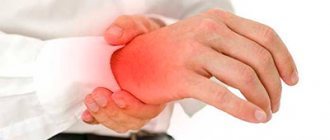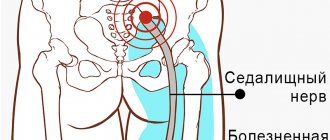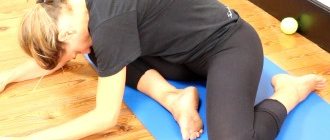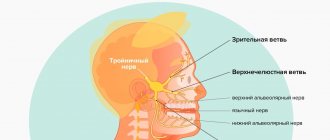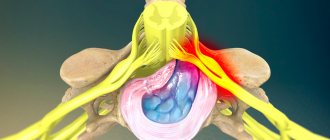How are medications selected?
Back pain can occur at any age in all clinical groups of patients. Usually this is not an independent pathology. As a rule, pain is a concomitant symptom of certain disorders of the body.
Injections for pain in the back and lower back are prescribed by the doctor after collecting complete information for the medical history. After identifying existing diseases, you can prescribe treatment that will help stop pain, remove inflammation, relieve swelling and enhance recovery. What injections for back and lower back pain can alleviate the patient’s condition?
Nonsteroidal anti-inflammatory drugs (NSAIDs)
Most often, NSAID injections are used to relieve pain in the spine, because they extremely quickly affect the source of inflammation, removing unbearable pain, stiffness, swelling, and fever.
Nonsteroidal anti-inflammatory drugs are prescribed for the following pathologies:
- low back pain of a long-term and wave-like nature due to a pinched nerve;
- radiculopathy and osteochondrosis;
- intercostal neuralgia;
- traumatic syndromes in the back;
- intervertebral hernia, etc.
NSAID therapy is external in nature, while analgesic injections for back pain have a number of contraindications. To reduce side effects, it is recommended to use modern NSAIDs - COX-2 inhibitors.
Ketorol
This medicine is quite popular as injections for back and lower back pain. Its main component is ketorolac, which is a strong anti-inflammatory non-steroidal substance.
This medication should not be used if you are hypersensitive to ketorolac, as well as during pregnancy, breast lactation, and children under 16 years of age.
Ketoprofen
A medicine based on ketorolac trometamol. Ketoprofen has a strong analgesic effect. To avoid side effects, you should strictly follow the dosage shown in the annotation.
Xefocam
The main component of this medication is lornoxicam. Relieves pain in the lower back and back with a large number of side effects. Should be used only as prescribed by a doctor.
Texamen
This pain reliever contains tenoxicam with additional components. Injections are not recommended for patients with hypertension, diabetes, liver and gastrointestinal diseases.
Diclofenac
The so-called “golden mean” among similar drugs with analgesic activity. With one injection you can eliminate discomfort in the back and lower back associated with muscle contraction and overstrain. However, it has quite a few contraindications. Among them it is worth noting individual intolerance, gastrointestinal diseases, cardiac pathologies, etc.
Meloxicam
This product contains movalis. The medicine is of the latest generation, which means it has minimal side effects. It is believed that these are good injections for back and lower back pain. It is well tolerated and has a fairly long-lasting effect.
Dexalgin
The main component of this drug is dexketoprofen. Relieves back and lower back pain due to pinched nerves and various diseases of the musculoskeletal system. The course of injections is no more than 5 days.
Causes of sciatica
The sciatic nerve originates in the spinal cord and continues to the phalanges of the toes. In the knee area it bifurcates: one part is responsible for the innervation of the lower leg, and the other for the foot. This structure also provides sensitivity to the muscles of the lower extremities. It regulates the connection of the tissues of the listed areas with the central nervous system.
What can cause a person to get a cold in the sciatic nerve? Symptoms of the problem appear after a long stay in a draft, in cold water or due to hypothermia of the entire body. The inflammatory process can also be caused by infringement of this structure. A similar situation occurs with degenerative lesions of the spine.
Among the main causes of inflammation are the following:
- hypothermia of the body;
- infectious diseases (tuberculosis, herpes zoster, influenza, etc.);
- spinal injuries;
- osteophytes;
- diabetes;
- gout;
- heavy metal intoxication;
- spinal canal stenosis.
A sedentary lifestyle, predominantly sedentary work, and heavy lifting can contribute to the development of inflammation.
Muscle relaxants
Quite often, back pain occurs as a consequence of muscle spasms. There are usually two different types based on etiology:
- spasticity resulting from damage to brain activity;
- muscle pain and spasms due to musculoskeletal disorders.
Injections of muscle relaxants are prescribed to enhance the effect of NSAIDs and steroid medications. Injections should be carried out in full compliance with the dosage and administration rules.
Mydocalm
Relaxes the spinal muscles, blocks nerve endings and relieves back and lower back pain. Contains an active substance - tolperisone, which provides a local anesthetic effect. May cause allergies in patients intolerant to lidocaine.
Atarax
This drug is a piperazine derivative. Intramuscular injections relax the vertebral and smooth muscles of the back with a moderate effect on the gastrointestinal tract.
Contraindications: pregnancy, hypersensitivity to components, arrhythmia and renal failure.
Baclofen (Baklosan)
The main therapeutic component is baclofen, which helps reduce the excitability of sensitive nerve endings and impulses, relieving pain in the lower back and back. Contains contraindications for patients with Parkinson's disease, muscle cramps, epilepsy and intolerance to the components.
Hydroxyzine
The active ingredient is hydroxyzine. Injections help relieve muscle tone in the lower back and neurotic pain in the back. Its effects are similar to Atarax, since it is a piperazine derivative. Should be used with caution in patients with renal failure.
Tizanidine
The main substance in the composition is tizanidine. Reduces the aggravated tone of the skeletal muscles, removes spasms in the back, reduces muscle resistance during inert movements, and increases the power of free contractions. May have side effects at higher doses.
Sirdalud
Derived from tizanidine. Relieves various muscle tones, lower back pain of various etiologies, providing an analgesic effect.
Signs
When the sciatic nerve is cold, a person experiences a burning, paroxysmal pain in the lumbar region or buttocks, depending on which part of the body is cold. The pain progresses, it is difficult to endure, it descends lower, tending to the ankle along the back surface.
Other symptoms by which a person can understand that he has a cold in the lower back along with the nerve endings develop gradually:
- numbness of the buttocks;
- pins and needles sensation throughout the limb from top to bottom;
- spasm of the gluteal and thigh muscles;
- decreased sensitivity of the limbs;
- motor dysfunction.
With load or incorrect position, pain and other manifestations will intensify. In order to get rid of painful symptoms, a person will take positions that were previously unusual for him.
For reference! As the disease progresses, insomnia is possible.
If it is possible to reduce pain with the help of medications, and the person does not go to the doctor, then the disease will progress. With the development of sciatica, serious problems will arise: muscle weakness and atrophy;
- lack of limb reflexes;
- problems with urination, defecation;
- urinary and fecal incontinence.
Steroid drugs
Hormonal drugs create a strong anti-inflammatory effect, but at the same time they have a large number of side reactions. Steroid injections for back and lower back pain are prescribed for the following diseases:
- spinal intervertebral hernias;
- progressive radiculitis;
- ankylosing spondylitis;
- rheumatoid arthritis.
Flosteron
It contains a glucocorticosteroid. Injections are used mainly for severe forms of musculoskeletal diseases, when non-steroidal medications do not have an effect. The dosage is selected individually, taking into account the severity of the disease and the patient’s response to treatment.
Diprospan
The potent substance in betamethasone is a broad-acting steroid hormone. It has a large number of side effects, which the attending physician should warn about. Negatively affects the functioning of the adrenal glands. May be addictive if used frequently.
Hydrocortisone
Intravenous injections are prescribed for back pain of any nature, in particular rheumatic and intervertebral hernia. The dosage should be determined by the doctor individually, comparing the patient’s health status with contraindications.
Prednisolone
A drug from the group of glucocorticosteroids. Prescribed for back and lower back pain, diseases of the spinal column of various types. It has a fairly large number of side effects. The dosage is prescribed by the doctor as prescribed.
Kenalog
Contains triamcinolone acetonide. It is used as injections for various arthrosis, relieving inflammation and back pain. Has side effects.
Treatment with medications
At home, you can try to relieve the pain caused by a pinched sciatic nerve without medications:
- take the position in which the discomfort will be least pronounced (in most cases, pain is more easily tolerated in a position lying on your back, on the healthy side with the sore leg straightened);
- exclude physical activity and walking;
- do self-massage: rub, knead painful areas, excluding sudden movements.
You need to understand that such therapeutic measures do not help eliminate the cause of inflammation and pinching of the sciatic nerve. Therefore, as soon as the condition improves, you need to consult a doctor. The pathology is treated by a neurologist.
If there are symptoms inherent in the inflammatory process, it is prohibited to carry out warming procedures and rubbing the diseased area. In this case, the clinical picture intensifies, and the general condition worsens.
If the sciatic nerve is compressed, it is recommended to sleep on your side, preferably on a medium-hard or firm mattress. It is prohibited to take any medications without first consulting a doctor.
Nonsteroidal anti-inflammatory drugs
First of all, anti-inflammatory treatment is prescribed using appropriate agents. These help reduce the intensity of inflammation, pain, and swelling of the nerve. The mechanism of action of anti-inflammatory drugs is associated with the suppression of the production of prostaglandins, mediators of the inflammatory response.
Anti-inflammatory drugs are available with or without a prescription. More often, over-the-counter medications are prescribed, which are freely available in pharmacies. Medicines are available in the form of tablets, ointments, suppositories, and an injection solution for injections.
Along with non-steroidal anti-inflammatory medications, it is recommended to take probiotics to normalize the intestinal microflora.
Injections are most often prescribed for pinched sciatic nerves. Injections are given intramuscularly up to 3 times a day. A single volume of the drug is 2 ml. In combination, you can apply ointments with an analgesic effect.
One of the drugs used in the treatment of pinched sciatic nerve is Piroxicam. The drug is available in the form of an injection solution, gel, cream, tablets and suppositories.
Analogues of the drug are Meloxicam, Movalis, Amelotex, which are considered the safest among all non-steroidal anti-inflammatory compounds. Less safe are products based on nimesulide (Nimesil, Nice, Nimesulide), which irritate the mucous membranes of the gastrointestinal tract.
Other drugs used to treat sciatica: Ketoprofen, Celebrex, Ibuprofen.
Steroid medications
Drugs from the glucocorticoid group are used if non-steroidal anti-inflammatory drugs do not help relieve acute symptoms. This group includes the drugs Kenalog, Hydrocortisone, Prednisolone, Diprospan.
When hormones are administered by injection, the irritating effect on the mucous membranes of the digestive system is eliminated.
The mechanism of action of glucocorticoids is associated with the suppression of the inflammatory reaction, due to which the intensity of the clinical manifestations of sciatica is reduced: pain, swelling, impaired leg mobility, etc. Hormonal drugs are often injected into the area around the damaged branch. The blockade (this is the name of the procedure) is carried out only by a doctor.
Injection of glucocorticoids by blockade has advantages over oral medication and local treatment of the skin. The solution bypasses the gastrointestinal tract as it reaches the desired area through the bloodstream.
Muscle relaxants
Muscle relaxants help eliminate myotonic syndrome, that is, spastic pain in the affected area. The most popular means are:
- Clonazepam in a daily dosage of 0.5 mg (it is better to administer the medicine before bedtime);
- Tolperisone in the initial daily dosage of 150 mg, divided into 3 equal doses, with a gradual increase to 450 mg;
- Clonidine in a daily dosage of 0.1 mg;
- Carbidopa in a daily dosage of 12.5/50-25/100 mg.
Contraindications to treatment with muscle relaxants:
- severe kidney or liver failure;
- peptic ulcer of the stomach and duodenum;
- epilepsy and risk of seizure;
- Parkinson's disease;
- cerebral vascular diseases;
- hypersensitivity to the components of the drug.
Adverse reactions include headache and dizziness, decreased blood pressure, nausea, and seizures (rarely). If there are contraindications to taking tablets and giving injections, you can use ointments, which, although they act more slowly, are safer:
- Finalgon;
- Dolgit;
- Ketonal;
- Fastum.
The drugs are not muscle relaxants, but have a similar therapeutic effect. The products activate blood circulation, which helps relieve muscle spasms and pain.
Chondroprotectors
Medicines in this group are prescribed to quickly restore connective tissue, regenerate the structure of the spine and reduce inflammation in the back.
Chondroitin sulfate
The active substance in the form of chondroitin is used to eliminate destruction of bone and cartilage tissue. During the course of injections, inflammation and pain in the lower back go away, and joint mobility is normalized.
Alflutop
Injections are given intramuscularly to relieve pain in the back and lower back. Included in the list of the best chondroprotectors. It regenerates cartilage and fights intervertebral hernia.
Combined painkillers
After completing a course of injections for back and lower back pain, the patient may be prescribed other forms of medications - ointments, tablets, suppositories. These drugs will have a supporting effect and prevent the development of possible complications.
The fight against back pain is a long-term and complex process. Anesthetic injections give a good and lasting result, but they should only be used under the supervision of a doctor.
Bubnovsky's exercises
Treatment of pinched sciatic nerve using the method of Sergei Bubnovsky is called kinesitherapy. In this case, exercises against pinched sciatic nerves are best done in special centers using simulators developed by the doctor himself under the supervision of a specialist. But not everyone has this opportunity, so you can practice at home using special videos.
However, preliminary differential diagnosis will be needed in any case. Most exercises will need to be performed through pain, which, of course, is quite difficult. To relieve pain, stretching the muscles of the legs and back in the pool is useful, since water greatly reduces body weight, as a result, pain decreases, and exercise becomes easier. Muscle stretching on the Swedish wall is useful:
- do squats while holding it;
- hang on it and do the pedaling exercise, which has a beneficial effect on the leg muscles.
Kinesitherapy not only helps to normalize the condition of the musculoskeletal system, but also to normalize other body systems. If you are just starting to treat your sciatic nerve or want to do exercises for prevention, you can try doing adaptive gymnastics using the Bubnovsky method.
Treatment using the Bubnovsky method involves performing exercises specifically selected for certain muscle groups. It is important to do the exercises regularly and monitor your own discipline. The proposed gymnastics for inflammation of the sciatic nerve will help normalize the condition of the body and normalize the musculoskeletal system.
- To relax and arch your back, you need to take the starting position sitting on all fours. Feel your back muscles and let them relax. Then bend your back as you inhale and arch it as you exhale. Repeat the exercise at a moderate pace 20 times.
- In the same position, move your right leg back and sit on your left. Pull your left leg forward, lowering your body as low as possible. Perform 20 repetitions for each leg.
- The starting position is the same. Bend over, stretching your entire body forward without using your lower back muscles. There is no need to rush while doing this; watch your breathing and balance.
- In the same starting position, lower your torso to the floor on bent arms while exhaling. As you inhale, return to the starting position and focus on your heels. Repeat six times.
- Lie on your back, clasp your hands behind your head, bend your knees. Pump up your abs by lifting your body and touching your elbows to your knees.
Bubnovsky's adaptive gymnastics is suitable for those who are just starting to treat the sciatic nerve. It helps strengthen and stretch muscles. It is best to perform the exercises on an empty stomach, devoting at least 20 minutes to them. Excessive sweating will tell you that you are doing everything right. After finishing the exercises, take a regular or contrast shower. They are performed as follows:
- Starting position – sitting on your heels. As you exhale, rise up, spread your arms to your sides, and while inhaling, return to the starting position.
- Do cleansing breathing by placing your hands on your stomach and exhaling through pursed lips.
- To strengthen your abs, lie on your back, bend your knees and lift your body with each exhalation.
- Lie on your back, cross one leg over the other. Lift the body, however, not diagonally.
- Rotate your pelvis while standing on your knees and lifting your knees.
- Starting position: kneeling. Bend your body forward and backward. Lie on your stomach, straighten your legs and lift them off the floor, alternating with raising your body.
- Lie on your side, lift your leg up. Hold it mid-swing. Alternate both legs.
- Do push-ups from the floor.
- Taking a sitting position, move on the gluteal muscles. And in a standing position on all fours, swing forward and backward.
Proper gymnastics will help restore the affected sciatic nerve. But remember that pinching requires contacting a doctor - he may prescribe additional measures. Once sciatica is cured, you should also do exercises. Running and cycling are useful. Choose an active lifestyle for yourself, and in the future you will not have to face such violations.

